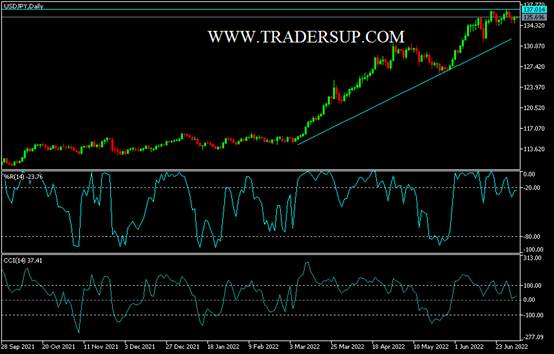For the second day in a row, the price of the US dollar against the Japanese yen is rebounding higher, stable around the level of 135.72. It rebounded after selling operations that pushed it last week towards the support level 134.75 and settling around the level of 135.70 at the time of writing the analysis, and the pair will continue to move in narrow ranges until the announcement of the content minutes of the last meeting of the Federal Reserve, then US job numbers.
The yen is a popular asset during turbulent times.
The price experts say that the impact of the weak yen on inflation in Japan is limited. That’s according to Yuri Sasaki, professor of economics at Meiji Gakuin University in Tokyo. Since the Japanese yen began its sharp decline against the dollar in March, it has only raised Japanese core inflation by about 0.4 percentage points, and the conclusions of his research support the BoJ’s position that currency movements do not affect inflation much and should not affect the policy direction of the BoJ.
BoJ Governor Haruhiko Kuroda has so far maintained his position that the Japanese economy still needs support from very low interest rates, and policy should never target foreign exchange rates. And it remains steep among its peers as central banks around the world rush to raise interest rates to tame inflation. “What is more important than looking at the weakness of the Japanese yen is knowing the effects of supply-side shocks,” Sasaki added in an interview last week. He added that the impact of a weak yen on inflation was “really very small”. A 1% weakness in the yen against the dollar lifted the core CPI by 0.02 percentage points, according to Sasaki’s calculations.
However, with the national core CPI remaining above the BOJ’s 2% target for two consecutive months, speculation about normalization from the central bank is likely to persist. Sasaki added that unlike past periods of oil price booms and a weak yen, the current wave of inflation is beginning to show a more sustainable impact from supply-side shocks and commodity price increases. He said there will be more moves toward higher wages as the economy recovers.
It added that ensuring that domestic demand and consumer spending did not fade over the next two years was important. “We are seeing movements that go against the belief that prices don’t budge,” Sasaki also said, “I don’t see a reason why Japan alone will see inflation return to zero.”
More importantly, a group of US monetary policy makers will speak publicly from Wednesday this week when the Fed will also release the minutes of the June meeting in which most FOMC members favored raising US interest rates to a “moderately restricted” range of Between 3% and 3.5% by the end of the year.
There was also broad support from the FOMC to raise the federal funds rate to four percent or more next year in order to return the inflation rate to the Fed’s target of 2 percent, but financial markets have recently begun to bet that such These levels are unlikely. to look at her. The Fed’s outlook is based on the assumption that the US labor market will remain strong even as the bank implements the fastest and strongest monetary tightening for decades, which is why markets are likely to be closely scrutinized in Friday’s non-farm payroll report.
There is no change in my technical view of the price performance of the USD/JPY currency pair, as the general trend is still bullish and may remain so for a longer period of time, as the US dollar is still the most fortunate in the expectations of raising US interest rates strongly throughout 2022 and the economic performance in a way. A much better year than the Japanese economy, which is still suffering and needs more stimulus.
The most important resistance levels for the dollar yen today: 136.20, 137.00 and 138.65, respectively. Technical indicators are still moving higher. A first break of the general trend will not occur without moving below the 130.00 support. The USD/JPY pair may remain moving in narrow ranges with an upward bias until the reaction to the most important forex market events.

